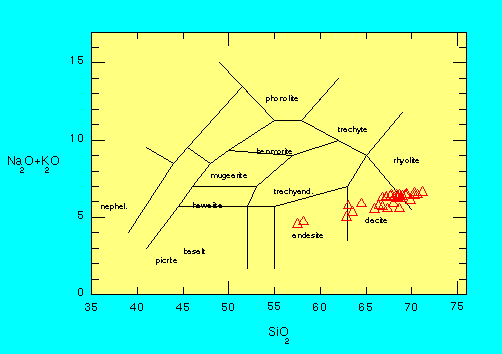Petrology
Analysis done by Meyer-Abich (1956); Cohen (1881); Hague and Iddings (1886); Williams and Meyer-Abich (1953) have concentrated their efforts on the Tierra Blanca Joven (TBJ) deposits and the Islas Quemadas dome. Only Hart (1981) includes analysis from an earlier tephra, which he refers to as the Apopa tephra.
All these authors agree on the petrographic classification of TBJ. It is described as a bleached white, highly vesiculated pumice with phenocrysts of hornblende, plagioclase (An30-40), hypersthene, magnetite and ilmenite. The glassy matrix has a refractive index of 1.494-1.502 and based on oxide compositions a crystallization temperature of 805-809o C was calculated (Hart, 1981).
Chemical composition of TBJ rocks show a silica content of 66-71%, which classifies them as rhyodacites to rhyolites. These results also suggest that stratification of the magma chamber and magma mixing occured prior to the TBJ eruption.

Cox-Bell-Pank (1979) diagram showing the rock types for several samples from Ilopango.
Hart (1981) notes that during the initial phases of the eruption, more basaltic material was erupted first, followed by silic material in the latter stages of eruption. These results are contrary to what is commonly found in large tephra eruptions, were the first material erupted usually is the most siliceous. Hart (1981) suggests that for this to occur, the geometry of the magama chamber would have to have been of a higly irregular shape, proposing a "chamber containing two broad and gentle cupolas or lobes."
